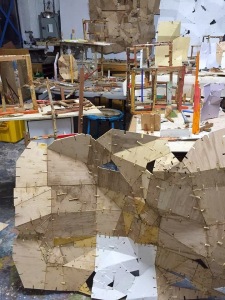By Sharon Butler

Work in progress in O’Leary’s studio
On the occasion of her forthcoming solo exhibition at the Irish Arts Center, “The Geometry of Dirt,” I asked O’Leary to put together a list of the things that she’s thinking about.

1. I collect snap shots of “things people do” that form their own sense of logic outside of mainstream conformity. I made a few books of images like these, how people paint things to mark territory, etc.



2. Paint and language as solidified history.
3. Dirt, Filth- as solidified history… physical, emotional, cultural, economic, the thing it’s made of, the shame and scandals it encloses. The dirt that we collect, or collects upon us, survive on, live with, on, the mad fights we have over it…The floor of my studio, the acres of land I grew up on, and the women who farmed it and shaped me.
4. The Women’s Dirty Protest in Northern Ireland / large and small acts of insubordination.
5. Poetry: Condensed language
A Small Farm
Michael Harnett
All the perversions of the soul
I learnt on a small farm.
How to do the Neighbours harm
by magic, how to hate.
I was abandoned to their tragedies,
minor but unhealing:
bitterness over boggy land,
casual staling of crops,
venomous cardgames
across swearing tables,
a little music on the road,
a little peace in decrepit stables.
Here were rosarybeads,
a bleeding face,
the glinting doors
that did encase
their cutler needs,
their plates, their knives,
the cracked calendars
of their lives.
I was abandoned to their tragedies
and began to count the birds,
to deduct secrets in the kitchen cold
and to avoid among my nameless weeds
the civil war of that household. (15)
The White Year
Vona Groake
I am told that memory can’t afford
to care less about what it brings to light
just as I’m told the table does not
occupy itself with cleanliness
nor the made bed with desire,
but it is difficult to believe.
I do not imagine it simple to strip
from any given afternoon
the intentions of the day.
Not when a contingent darkness
announces itself at the door
like an ordinary to-do
and not when, in the winter garden,
the beautifully managed trees
toy with shadows of themselves.
A skim of plausible survival
settles on what I do while, in the museum
of the everyday, no dust whatsoever
is to be found on the bedside chair,
unopened perfume,
impeccable gold quilt.
It may well be possible to separate
into a fiction of forgetfulness,
the accomplished house
but I don’t believe in it either.
There is before and after,
surely, and there is discretion
to be accounted for, and grief,
night after night, city after city,
word after functional word.
This is whatever time I have.
My whole body has to find a way
to be in possession of itself
like a shop selling only white things
or the way two bridges on the same river
will have knowledge of each other.
6. Pairing strange bedfellows: example: Reading Zizek’s Living In the End of Times and Craig’s List for sale and free…things we think we need–the urgency in every day vernacular signage.
7. Mosaics/collections of things and how they are displayed, from the Metropolitan Museum, flash flood economics of small pop up ventures, flea markets, sidewalk sales…street vendors– survival, everywhere.
8. Samuel Beckett–Middle age-the holes in certainty– brevity
9. Espalier–and trees in the West of Ireland shaped by harsh winds
10. Lament– Sean nós singing— lament, cultural, and personal. Using its form as an axis for painting, the simplicity and complexity of it, how it stands alone and unaccompanied, yet can be highly ornamental and lyrical.
From Wikipedia: Alternatively, it is simply “the old, traditional style of singing” and therefore is not always ornamented. It varies very much from one part of the country to another, as according to Hiúdaí Ó Duibheannaigh, who served on the Irish Folklore Commission from 1936-39, “…people now, that word being used these last forty years, think it’s a particular style of singing: it’s not![3]
Sean-nós songs can be relatively simple, though many are long, extremely stylised and melodically complex. A good performance classically involves substantial ornament and rhythmic variations from verse to verse.
Ó Canainn identifies most ornamentation as melismatic ornamentation. This is when a note is replaced or emphasised by a group of adjoining notes, unlike intervallic ornamentation, in which additional notes are used to fill up an interval between two notes.’
10. Geometry–the hobbled geometry of our lives

A wall in O’Leary’s Bushwick studio.
“Helen O’Leary: The Geometry of Dirt,” Irish Arts Center, midtown, New York, NY. October 14 through January 5, 2014. The reception and an artist’s talk are on Tuesday, October 28, at 6:30 pm.
——
Two Coats of Paint is licensed under a Creative Commons Attribution – Noncommercial-No Derivative Works 3.0 United States License. For permission to use content beyond the scope of this license, permission is required.
